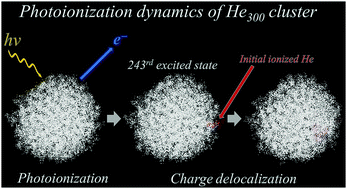Nuclear quantum effects in the direct ionization process of pure helium clusters: path-integral and ring-polymer molecular dynamics simulations on the diatomics-in-molecule potential energy surfaces†
Abstract
The direct photoionization of pure helium clusters, Hen (n = 100, 200 and 300), and its subsequent short-time process have been studied by path integral molecular dynamics (PIMD) and ring-polymer molecular dynamics (RPMD) simulations that can effectively describe the nuclear quantum effects in large systems. The modified diatomics-in-molecule (DIM) model [Calvo et al., J. Chem. Phys., 2011, 135, 124308] has been used to describe the electronic structures of Hen+ clusters. The PIMD simulations were able to reproduce the experimental ionization spectra having a broad and asymmetric nature, which can be ascribed to the inhomogeneity of the energy levels of He atoms in the inner and outer regions of the cluster. From the RPMD simulations, it is found that the ionized helium cluster in the higher excited state is followed by fast electronic state relaxation via nonadiabatic charge transfer including a small contribution of nuclear motions, and subsequently by slow relaxation of the cluster structure.



 Please wait while we load your content...
Please wait while we load your content...